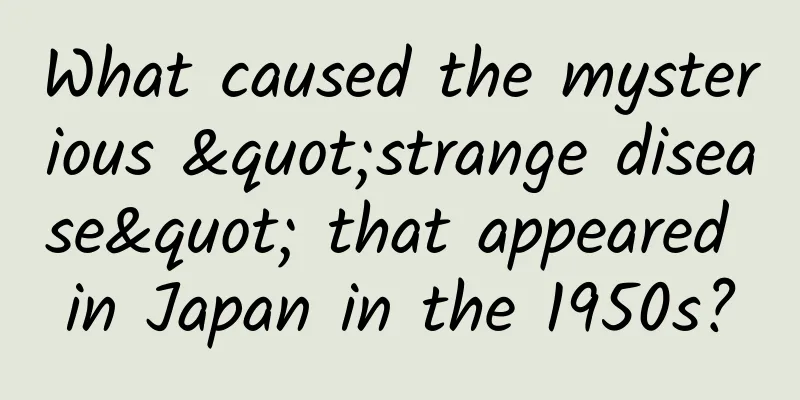What caused the mysterious "strange disease" that appeared in Japan in the 1950s?

|
In the 1950s, the villagers of Minamata Village in Japan went out to sea to fish as usual, and undoubtedly returned with a full load, because the fishery resources in Minamata Bay, which they depended on, were extremely rich. The caught fish are made into delicious dishes and served on the table. After the villagers have feasted on them, the remaining leftovers are left to the cats and dogs at home. It was also at this time that the animals in Minamata Village began to behave strangely. For example, seabirds flying in the sky inexplicably fell from mid-air, and cats in the village twisted their bodies desperately, as if they were dancing... People could not understand this strange phenomenon. Although there was a hint of panic, it was not taken seriously because it had not yet occurred in humans and the cause could not be found. Video material of Kumamoto Medical University in Minamata Until 1956, some people in Minamata Village also developed a strange disease. Patients often showed symptoms of poor coordination of hands and feet, and even difficulty walking, movement disorders, mental retardation, hearing and speech disorders, numbness of the limbs, sensory impairment, and reduced visual field. Doctors in hospitals at the time could not find the cause of the disease, let alone treat them effectively, and eventually the patients died painfully due to lack of adequate nutrition. Generally, when such an unconfirmed disease breaks out, people will think that the disease is contagious, so everyone in the village will be in a panic, fearing that they will be infected. At that time, this disease was considered an "ominous sign" or "an inescapable disease". Now, we call this strange disease "Minamata disease" (mercury poisoning). As for the cause of this disease? It is because the Chisso Chemical Plant in Minamata Village discharged nearly 1.5 million tons of mercury-containing wastewater into the bay. Chisso Chemical Plant and Minamata Village During the Meiji period in Japan, Minamata Bay gradually attracted a large number of fishermen due to its abundant seafood and sea salt. As the concept of towns was introduced from the West, the Japanese Emperor named this place Minamata Village in 1889. At that time, there were only 2,325 households here. 20 years later, Japan's Chisso Company was established in Minamata Village and began to produce fertilizers. At that time, Japan had a huge demand for chemical fertilizers such as nitrogen fertilizers, so Chisso Company took this opportunity to develop rapidly and the company's scale continued to expand. Of course, the growth of Chisso also boosted the local economic development. Minamata Village was transformed from a small fishing village into an industrialized city. Since then, the development of Minamata City has been closely linked to the growth of the company. So in 1932, Chisso developed a new business - it began to produce acetaldehyde plastic raw materials and employed a large number of Minamata residents, providing them with jobs. In the production process, Chisso used a lot of metallic mercury to speed up the production of acetaldehyde. Well, using mercury to speed up the reaction is not a big problem, but they did not do a good job of post-production and discharged the mercury-containing wastewater directly into Minamata Bay. Chisso factory discharges wastewater After flowing out of the factory's drainage pipes, the mercury is absorbed by plankton, which is then devoured by horse mackerel, sardines and shellfish, which in turn are eaten by larger creatures such as cuttlefish and black sea bream... At each step, the mercury content in the organisms continues to accumulate, eventually landing between a pair of chopsticks. Screenshot of Minamata City Museum In Minamata Bay and the nearby waters, the fish have been seriously polluted, but it is not obvious from the appearance, so people still keep eating fish without knowing that the fish in the sea have been polluted. In the end, they all developed strange diseases, which is mercury poisoning. Mercury, element 80 of the periodic table Some symptoms of mercury poisoning include difficulty speaking and numbness in the limbs, but simply saying "mercury poisoning" is too vague because mercury, the 80th element in the periodic table, can exist in many chemical forms, each with its own characteristics. For example, mercury, which is commonly seen in thermometers in the form of a silvery white liquid, is quite dangerous. In 2014, a doctor in India secretly injected liquid mercury into a teenage boy's forearm after treating him for several months in an attempt to transform his bones into a metal arm like Wolverine's. This is undoubtedly impossible. When the liquid mercury entered the boy's body, it began to evaporate into mercury vapor. The gas was absorbed by the lungs and caused tremors, and also caused damage to the kidneys. But this is not the "worst" side of mercury, because it is still inorganic, meaning it has no carbon to induce undesirable interactions with carbon-rich biomolecules. The organic form of mercury is the most terrifying, and the wastewater discharged by Chisso contains a type of organic mercury called methylmercury. Methylmercury is an organic form of mercury compound with a molecular formula of one mercury atom with one carbon atom and three hydrogen atoms. In carbon-containing organisms such as the human body, organic mercury will combine with certain biological molecules in the human body and disguise itself as one of the many amino acids contained in the human body. In this way, organic mercury can be "smuggled" into the baby's body and brain area through channels such as the placenta and blood-brain barrier. This is also why most of the children born in Minamata Village at that time became children with cerebral palsy, because methylmercury flowed from the pregnant mother's body through the placenta to the baby. In 2004, a mouse experiment proved this cruel process. In addition, sometimes we have to admire the efficient absorption capacity of our intestines, because our intestines can absorb up to 95% of the methylmercury contained in each fish. These methylmercury will enter the blood cells and bind to hemoglobin, a small part of which will enter the liver, and most of it will flow to the brain, wreaking havoc in various areas of the brain and causing nerve damage. After the brain has had enough, the methylmercury will slowly turn back into inorganic mercury and remain in the brain for several months. The emergence of the Minamata Convention This large-scale mercury poisoning incident sounded the alarm for Japan and the world. Half a century later, the United Nations formulated a treaty to manage the use of mercury, the Minamata Treaty. 87 countries and regions, including China, have signed this convention. On April 28, 2016, the 20th Session of the Standing Committee of the 12th National People's Congress of the People's Republic of China approved the Minamata Convention on Mercury, which covers the entire "life cycle" of anthropogenic mercury pollution, including banning the establishment of new mercury mines, eliminating existing mercury mines, regulating handicrafts and small-scale gold mining, and reducing mercury emissions and use. The ecosystem is a circle. The environmental pollution caused by humans will eventually come back to us. We have all called for protecting the environment for decades. I hope we can truly do it in the future. |
>>: It remains an unsolved mystery for mankind.
Recommend
World Beauty Day丨The most cost-effective "beauty" method, you may have been doing it wrong
November 7th of each year is World Beauty Day, wh...
How to build a website locally? How to build a website on a local computer?
As a website SEO optimization personnel, how to o...
Why do we have multiple languages in our dreams?
© Emmanuel Lafont Leviathan Press: I remembered a...
Are you proud of your height of 1.8 meters? Even shorter than a Shandong green onion
When talking about Shandong, many people's fi...
Baidu Maps helps you predict the future, so you don’t have to fight the traffic during the May Day holiday
The May Day holiday is halfway through. Are you s...
Himalaya FM product analysis!
Pan-entertainment has always been in the limeligh...
Look at how the ancients celebrated New Year’s Day, that’s how we celebrate a festival!
New Year Come with the New Year's vigor Come ...
Three children infected with pneumonia were rushed to the hospital. Was it their parents’ good intentions that led to bad consequences?
Recently, in Handan, Hebei A mother posted a vide...
How can online and offline APPs complement each other’s strengths?
The specific strategies for enterprises to implem...
What's going on with Norway closing all schools? Why is Norway closing all its schools?
At a press conference on the afternoon of the 12t...
3 loops that Tik Tok uses to retain users!
This article divides the operation of Douyin into...
Mengzhuangyuan AI learning all-in-one machine experience: a learning companion for children and an educational tool for parents
Recently, Yue Yunpeng, a well-known crosstalk art...
The starting price of the Borgward BX3 is expected to be less than 100,000 yuan. Don't worry about whether it comes from Foton or Germany.
Since Borgward entered the Chinese market in 2016...
Weibo Advertising-A Customer Acquisition Guide for the Wedding Industry!
The wedding photography industry has different wa...
Master the mainstream APP application market channel operation strategy with zero foundation
This article introduces paid CPD promotion in app...









